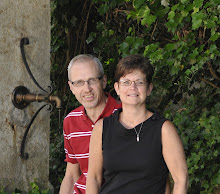Monday, March 31, 2008
The Bible
Printed on this wall, is the entire Bible. It was an amazing thing to see. This wall was actually a partition between our meeting room and the church. What a great way to fill white space!
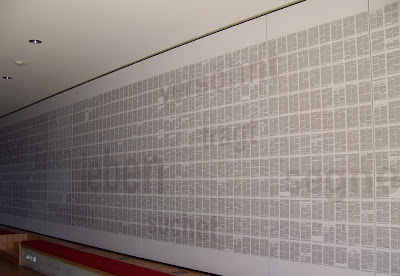
The leavers
There's always a long line of people who leave Janz Team and BFA each year. There are 10 or 12 more that should have been in this line who were not at the conference.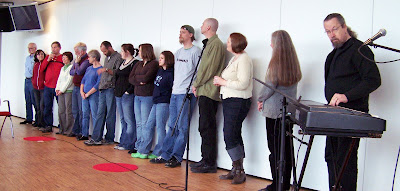 We also said goodbye to our grads. Three of them were also not at the conference, so for us, this is a pretty big Janz Team graduating class.
We also said goodbye to our grads. Three of them were also not at the conference, so for us, this is a pretty big Janz Team graduating class.
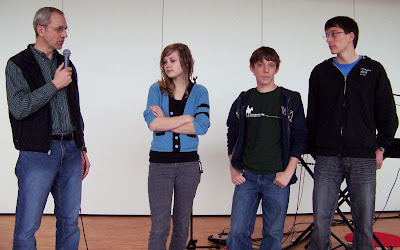
Free time at the conference
Mission Conference
On Wednesday afternoon we arrived in Swäbisch Gmünd where our mission conference was held this year. We had a lovely facility to enjoy, as well as a fantastic speaker (one of Howard's professors from his seminary days) and delicious food. It seems I mostly took pictures of us eating (which we seemed to do an awful lot of!) but the rest of the conference was also very, very good.
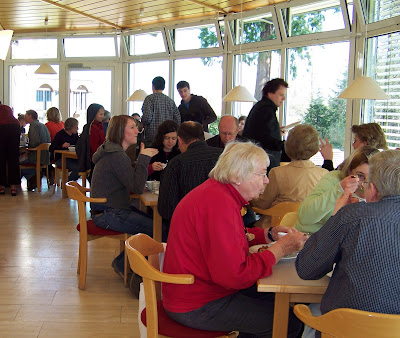


Sunday, March 30, 2008
The Fuggerei
On Wednesday morning we left Munich, stopping in the city of Augsburg along the way to see the "Fuggerei". It was fascinating and was my highlight of this trip. I took this information from "Wikipedia" which in this case, proved to be a very accurate source.
"The Fuggerei is a walled enclave within the city of Augsburg, Bavaria. It takes its name from the Fugger family and was founded in 1516 by Jacob Fugger the Younger (known as "Jacob Fugger the Rich") as a place where the needy citizens of Augsburg could be housed. By 1523, 52 houses had been built, and in the coming years the area expanded with various streets, small squares and a church. The gates were locked at night, so the Fuggerei was, in its own right, very similar to a small independent medieval town. It is still inhabited today, affording it the status of being the oldest social housing project in the world.
The rent was and is still one Rheinischer Gulden per year (equivalent to 0.88 Euros), as well as three daily prayers for the current owners of the Fuggerei - the Lord's Prayer, Hail Mary, and the Nicene Creed. The conditions to live there remain the same as they were 480 years ago: one must have lived at least two years in Augsburg, be of the Catholic faith and have become indigent without debt. The five gates are still locked every day at 10 PM.
The Fuggerei was first built between 1514 and 1523. Expanded further in 1880 and 1938, the Fuggerei today comprises 67 houses with 147 apartments, a well, and an administrative building. There is no shared accommodation; each family has its own apartment, which includes a kitchen, a parlour, a bedroom and a tiny spare room, altogether totalling about 60 square metres. Ground-floor apartments all have a small garden and garden shed, while upper-floor apartments have an attic. All apartments have modern conveniences such as television and running water. One ground-floor apartment is uninhabited, serving as a museum open to the public. The Fuggerei now houses senior citizens.
Wolfgang Amadeus Mozart's great-grandfather, the mason Franz Mozart lived in the Fuggerei between 1681 and 1694, commemorated today by a stone plaque.
The Fuggerei was heavily damaged by the World War II bombings of Augsburg but has been rebuilt in its original style. The Fuggerei is still administered by members of the Fugger family."

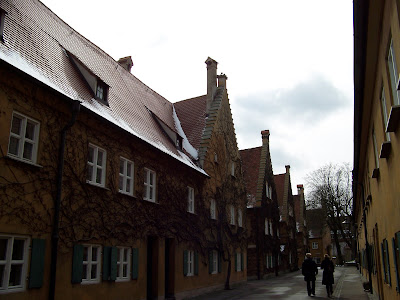
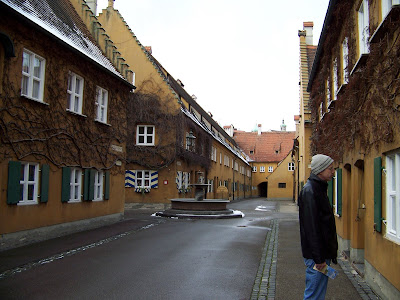
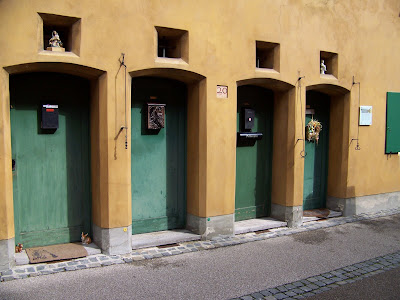 Inside the museum. Everything is SO small!
Inside the museum. Everything is SO small!

 The "automatic" front door opener.
The "automatic" front door opener.
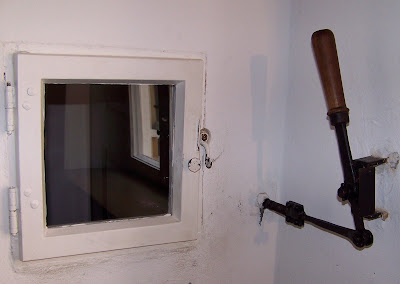
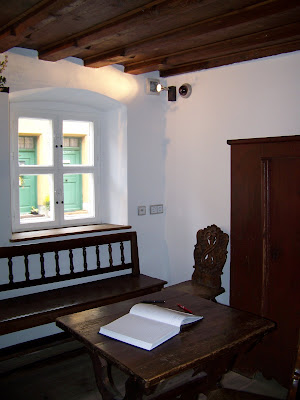

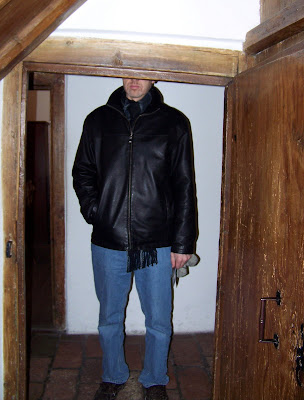

"The Fuggerei is a walled enclave within the city of Augsburg, Bavaria. It takes its name from the Fugger family and was founded in 1516 by Jacob Fugger the Younger (known as "Jacob Fugger the Rich") as a place where the needy citizens of Augsburg could be housed. By 1523, 52 houses had been built, and in the coming years the area expanded with various streets, small squares and a church. The gates were locked at night, so the Fuggerei was, in its own right, very similar to a small independent medieval town. It is still inhabited today, affording it the status of being the oldest social housing project in the world.
The rent was and is still one Rheinischer Gulden per year (equivalent to 0.88 Euros), as well as three daily prayers for the current owners of the Fuggerei - the Lord's Prayer, Hail Mary, and the Nicene Creed. The conditions to live there remain the same as they were 480 years ago: one must have lived at least two years in Augsburg, be of the Catholic faith and have become indigent without debt. The five gates are still locked every day at 10 PM.
The Fuggerei was first built between 1514 and 1523. Expanded further in 1880 and 1938, the Fuggerei today comprises 67 houses with 147 apartments, a well, and an administrative building. There is no shared accommodation; each family has its own apartment, which includes a kitchen, a parlour, a bedroom and a tiny spare room, altogether totalling about 60 square metres. Ground-floor apartments all have a small garden and garden shed, while upper-floor apartments have an attic. All apartments have modern conveniences such as television and running water. One ground-floor apartment is uninhabited, serving as a museum open to the public. The Fuggerei now houses senior citizens.
Wolfgang Amadeus Mozart's great-grandfather, the mason Franz Mozart lived in the Fuggerei between 1681 and 1694, commemorated today by a stone plaque.
The Fuggerei was heavily damaged by the World War II bombings of Augsburg but has been rebuilt in its original style. The Fuggerei is still administered by members of the Fugger family."
Bell pulls
Dachau
On Tuesday afternoon we went out to the city of Dachau to visit the concentration camp. It was a sobering sight and also a good day to visit since it was still miserably cold, damp and windy. At one time this camp housed over 70,000 prisoners. We could not imagine what it would have been like for them to stand in that cold, sometimes for hours, for roll call.
At one time this camp housed over 70,000 prisoners. We could not imagine what it would have been like for them to stand in that cold, sometimes for hours, for roll call.
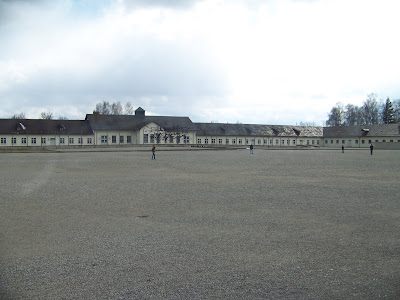 This is a monument made in memory of all those that suffered and died in the camp.
This is a monument made in memory of all those that suffered and died in the camp.
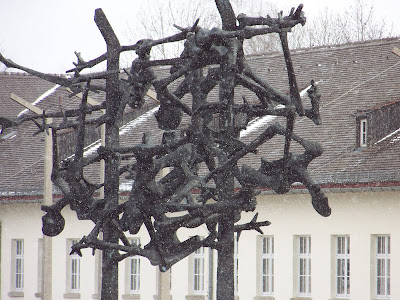
Brazilian Consulate
We had scouted out the location of the consulate on Monday afternoon, so on Tuesday morning we had no trouble finding it. Walking through the doors made us feel like we had left Germany and entered Brazil. What a wonderful feeling.
The girls even agreed to have their picture taken by the flag. They are good Brazilians!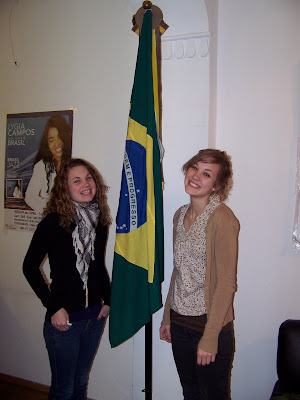 It took us well over an hour to fill out the forms and then we discovered that we didn't have all the documentation we needed. This was because we hadn't been told exactly what to bring! Yes, we definitely were back in Brazil! However, the very kind receptionist told us that we could mail in copies of what was lacking and then everything would be sent off to Brasília. We were told that hopefully the girls' cards would be ready to be picked up in 6 months, or at least for sure before the next presidential election which is in 2010!
It took us well over an hour to fill out the forms and then we discovered that we didn't have all the documentation we needed. This was because we hadn't been told exactly what to bring! Yes, we definitely were back in Brazil! However, the very kind receptionist told us that we could mail in copies of what was lacking and then everything would be sent off to Brasília. We were told that hopefully the girls' cards would be ready to be picked up in 6 months, or at least for sure before the next presidential election which is in 2010!
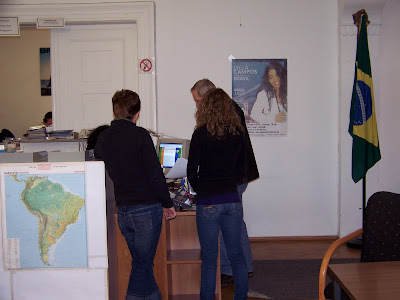
The girls even agreed to have their picture taken by the flag. They are good Brazilians!
Touring Munich
Subscribe to:
Posts (Atom)
